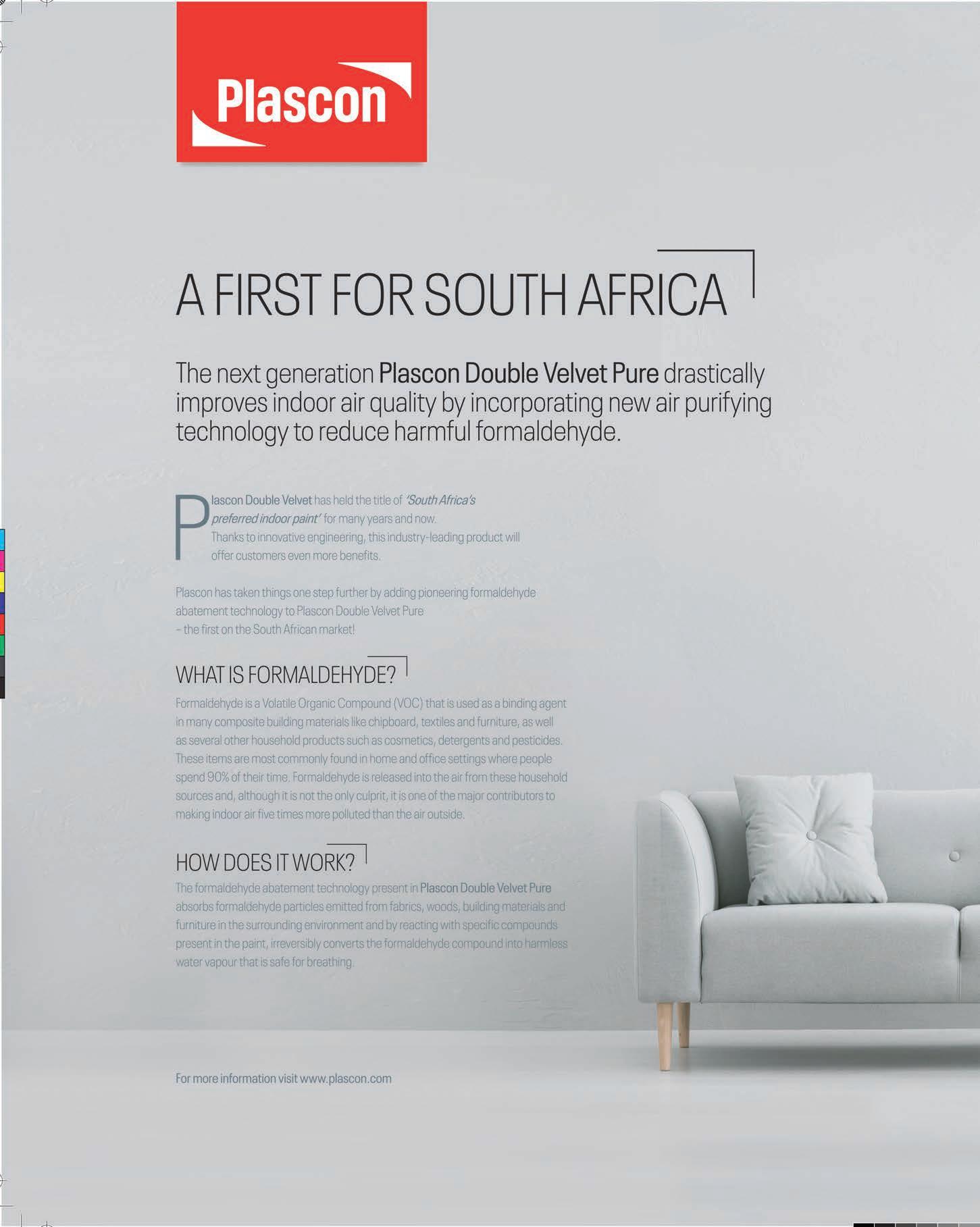TRENDY TIPPLES WITHOUT THE HANGOVER
WOMEN CHEFS CHANGING THE RESTAURANT GAME




LOCAL FOOTWEAR MANUFACTURERS WORKING TOGETHER










PUBLISHED BY

TRENDY TIPPLES WITHOUT THE HANGOVER




LOCAL FOOTWEAR MANUFACTURERS WORKING TOGETHER










PUBLISHED BY
Picasso Headline,
A proud division of Arena Holdings (Pty) Ltd, Hill on Empire, 16 Empire Road (cnr Hillside Road), Parktown, Johannesburg, 2193 PO Box 12500, Mill Street, Cape Town, 8010 www.businessmediamags.co.za
EDITORIAL
Editor: Anthony Sharpe
Content Manager: Raina Julies rainaj@picasso.co.za
Contributors: Keith Bain, Trevor Crighton, Deidre Forbay, Caryn Gootkin, Nigel Grimes, Tshifhiwa Tshivhengwa
Copy Editor: Brenda Bryden
Content Co-ordinator: Natasha Maneveldt
Digital Editor: Stacey Visser vissers@businessmediamags.co.za
DESIGN
Head of Design: Jayne Macé-Ferguson
Senior Designer: Mfundo Archie Ndzo
Advert Designer: Bulelwa Sotashe
Cover Images: Supplied
SALES
Project Manager: Gavin Payne
Sales: Brian McKelvie
PRODUCTION
Production Editor: Shamiela Brenner
Advertising Co-ordinator: Johan Labuschagne
Subscriptions and Distribution: Fatima Dramat, fatimad@picasso.co.za
Printing: CTP Printers, Cape Town
MANAGEMENT
Management Accountant: Deidre Musha
Business Manager: Lodewyk van der Walt
General Manager, Magazines: Jocelyne Bayer
No matter how frequently our convictions may be strained by load shedding, corruption, crime and the general madness of living in Mzansi, the fact remains that this really is a uniquely lekker country. It’s special.
Just ask any of the roughly 5.7 million people who visited our extraordinary nation in the past financial year – most of them from the African continent. We kick off this issue of Made in SA with the Tourism Business Council of South Africa’s opinion that, while that’s still quite a way off our pre-COVID-19 figures, it’s cause for optimism as we rebuild our tourism brand. Also cause for optimism is the range of agri-tech
innovations coming out of the country, not to mention the excellent footwear and apparel manufacturers, both of which we profile in this issue. All we need is structural support to help fully unlock the potential of these sectors.

There’s something to celebrate for the Epicurean inclined, with a trio of women chefs shaking things in South Africa’s unique culinary heritage. Wash it all down with a raft of new nonalcoholic tipples, and you just might feel comfortably reminded that, yes, it’s a crazy country, but it is quite lekker to be made in Mzansi at the end of the day.
Anthony Sharpe Editor15 BEVERAGES
A shift towards more responsible drinking.
21 INNOVATION
A pop-up micro childcare facility gives market moms a fighting chance.
23 APPAREL
South Africa’s product manufacturers work together to promote their handmade goods.
25 SPONSORED CONTENT: BABY STORES
The roll-out of the Baby Store-in-Store concept.
5
South Africa remains a value-for-money destination in various source markets. 7

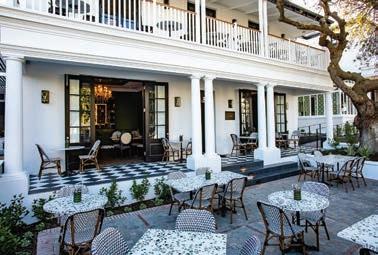

The South African tourism sector remains resilient in the face of many domestic and global challenges, writes
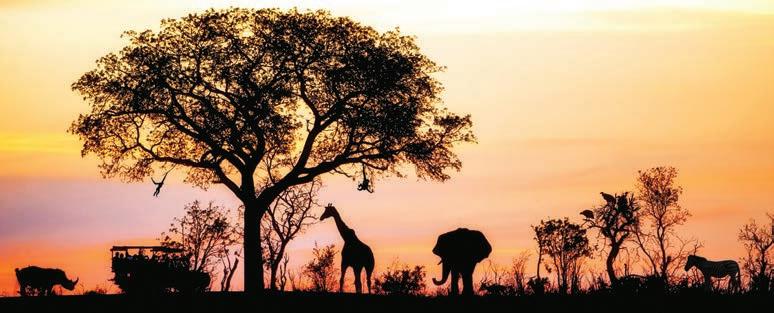
TSHIFHIWA
TSHIVHENGWA ,Multiple headwinds have been weighing on global economic growth, with many nations still reeling from the effects of the COVID-19 pandemic, global challenges and the rising cost of living.
In the last financial year, however, South Africa welcomed 5.7 million visitors from the continent and abroad, showing yet again that it’s still a preferred destination for many visitors and holidaymakers. We still have a long way to go in our recovery efforts to reach the 2019 levels of tourist arrivals and impact on the economy, but South Africa remains a value-for-money destination in various source markets, and we will grow arrivals to reach the targets we set for 2030.
Addressing delegates at the World Travel Market Africa in April 2023, Minister of Tourism Patricia de Lille said: “It is encouraging that arrival from other African countries continues to be our most substantial source of arrivals, with just over four million arrivals during this period.” This sentiment bodes well for diplomatic endeavours to strengthen relations with the rest of the continent.
The other two key markets in terms of arrivals are the United States and the United Kingdom. StatsSA’s tourism and migration data for December 2022 shows that the majority of tourists or visitors who touched down in South Africa in October 2022 were from the United Kingdom – that’s 26 928 visitors or 17 per cent of the total number of recorded visitors. In 2021, the United States held the number one spot as the largest overseas market for trade and tourism in terms of passenger volumes.
In the quest to remain competitive, the South African tourism sector has been boosted by some important partnerships. Last year, the biggest United States airline operator, Delta Air Lines, launched a new route between Cape Town and Atlanta. Direct flights between Atlanta and Johannesburg have been in existence since
CEO
ofthe Tourism Business Council of South Africa

2016, and the latest expansion between the three cities to four flights a week means South Africa’s tourism sector will benefit even more as American tourists are known to be big spenders.
Earlier this year, the Chinese government eased its three-year COVID-19 lockdown regulations. In March this year, South Africa welcomed the first group of tourists from China after a three-year hiatus. China’s significant contribution to the global tourism economy cannot be underestimated, so Air China’s first flight to South Africa since the pandemic marks an important shift in the world of tourism. “We will now have three flights a week between the two countries,” said Joe Hu, general manager for Air China in South Africa, as flight CCA867 from Beijing-Shenzhen touched down at O R Tambo Airport. “Each of our flights has at least 200 Chinese tourists. South Africa is a very popular destination for Chinese tourists.”
Before the pandemic closed borders, Chinese travellers around the world were ranked the biggest spenders, having spent R4.7-trillion in 2019, according to the World Tourism Organization.
Nevertheless, domestic travel remains the backbone of the sector. South Africans continue to travel their own country and boost tourism recovery.
As the world returns to life after the pandemic, South Africa has pushed to host important conferences, meetings and exhibitions, all of which position the country as a leader in the meetings, incentives, conferences and exhibitions industry. Events, such as the Africa Tourism Indaba, Meetings Africa, the World Travel Market and others, woo visitors to our
country. As hosts of these events, we pull out all the stops to ensure that the buyers return to their countries ready to sell South Africa as a desirable tourism destination.
To keep up with trends across the world, our industry is taking advantage of user-generated content on social media platforms, such as TikTok and Instagram, to showcase the country. There are now over five billion consumers on social media, making it a gold mine for travel marketers.
Social media travel influencers are new-age marketers that reach audiences in ways never explored before. We are also at the forefront of those spaces, ensuring we are always ready to take advantage of new opportunities. These platforms create jobs and economic opportunities for many young people in our country – one of the priorities of the South African tourism industry.
It’s no secret that the electricity shortage is a challenge that’s forcing the tourism sector and the entire country to look for reliable short- to medium-term alternative energy sources. Much like when the industry showed resilience at the height of the COVID-19 pandemic, hotels and small operators are running on generators to maintain standards in the short term. In the medium to long term, planning and adapting to smart and sustainable technologies have become necessary to respond to future shocks.
South Africa’s resilient tourism market has proven it can overcome multiple challenges over time. The issue of personal safety for all tourists continues to receive urgent attention. We are a warm and hospitable people whose diverse culture leaves a lasting impression on visitors, so they keep coming back for more.
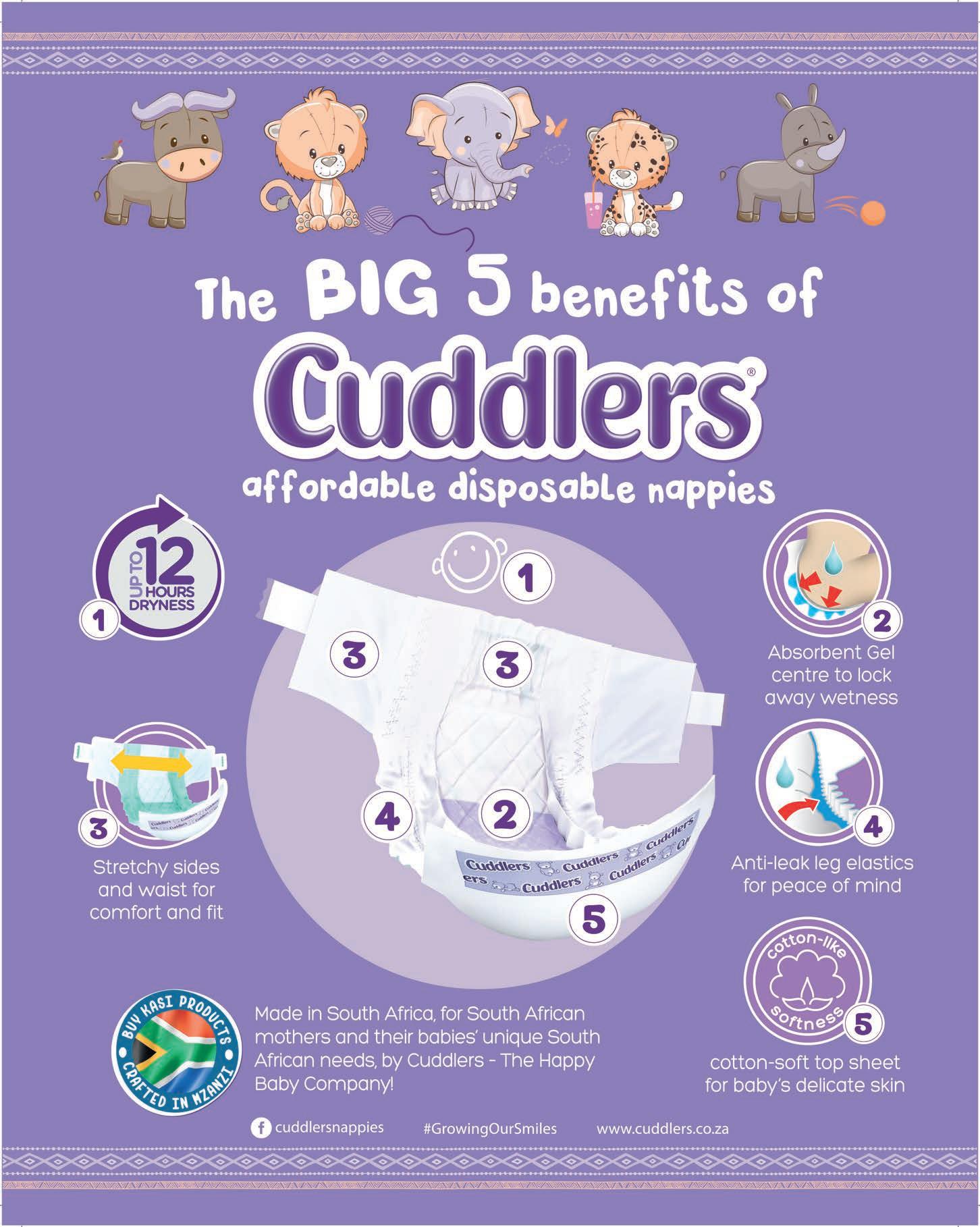
South Africa is home to a growing number of agriculture start-ups looking to bring technological innovation to bear on the farming and food production sector.
By CARYN GOOTKINAre we creating a supportive and conducive environment for innovation and entrepreneurship? It seems we are, at least insofar as agri-tech is concerned. Agri-tech start-ups in Africa raised over $480-million in 2021, a 250 per cent jump from 2020, according to AgFunder’s first Africa Agrifoodtech Investment Report. These are some local companies benefitting from this boom.
Desert Green is an agri-tech company transforming the informal agricultural value chain by enabling an efficient supply of fresh produce from small-scale producers to informal traders.
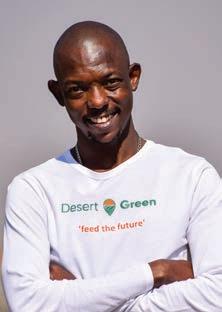
Retail trading in Africa is primarily informal. “Up to 90 per cent of trade today still happens in open-air markets and spaza shops because it’s cheaper and convenient for the end user,” says co-founder Tumelo Chiloane. “But this is a complete nightmare for small-scale farmers and traders. Over 86 per cent of small-scale farmers in South Africa rely heavily on informal and municipal markets to sell their produce. These markets are offline with
no visibility on demand or supply. The prices fluctuate and logistics costs are high, which inconvenience the informal traders who must physically go to the markets to buy stock, stand in long queues and pay for delivery back to their market stall. They also lose a big chunk of their selling time.”
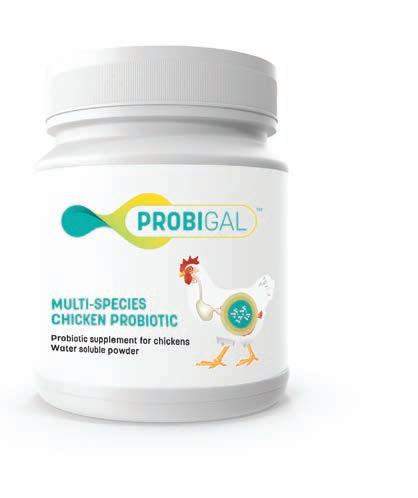
Desert Green’s main product is an e-commerce platform called GreenKart. “GreenKart is a business-to-business e-commerce platform enabling small-scale farmers to list crops that are available for sale, ready for harvest, or recently planted,” says Chiloane. “Informal traders can place an order online or via our WhatsApp chatbot, and we deliver directly to their stall for free within 24 hours, using geo-mapping for route optimisation.”
Desert Green is more than just a platform, however. “We also operate rented mobile cold-storage containers, allowing farmers to deliver to us in bulk, based on demands,”
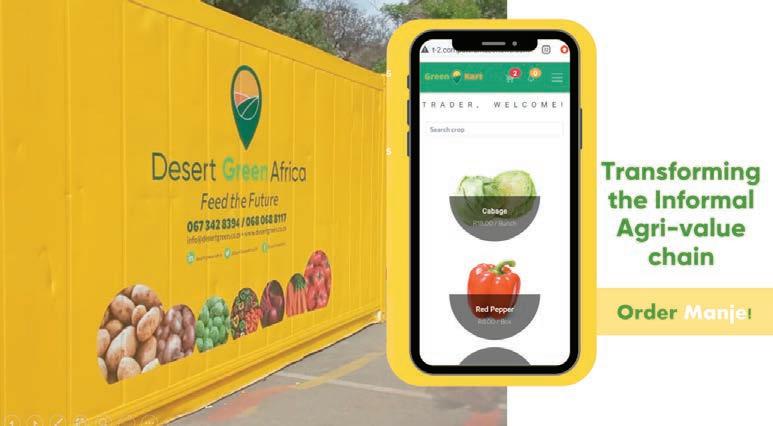
says Chiloane. “The benefit of shared transportation is that their logistic costs are lowered by up to 30 per cent, and their post-harvest losses are reduced. Another key offering is our Buy-Now-Pay-Later feature that allows traders to order stock and pay within seven days, based on alternative credit scoring, to improve their buying power.”
“Venture capitalists are starting to take note of the immense value that is yet to be unlocked in the African agri-tech space, both socially and economically,” says Chiloane. “And if venture capital funding is not available, there are alternative sources of funding in the form of pitch competitions and grant applications, which are usually more easily accessible for early-stage start-ups like us.”
Biotikum is a Stellenbosch-based biotech company specialising in the research and development of probiotic solutions for the agricultural industry to promote sustainable farming on the African continent.
In the agricultural industry, the use of antibiotics in animal farming has become a growing concern due to the development of antibiotic-resistant bacteria. “Antibiotic resistance poses a major threat to humanity, as infections that become resistant can kill once again,” says Liesel van Emmenes, chief administrative officer and managing director of Biotikum. “It is prudent that antibiotics only be used as treatment, not as preventative measures. We believe that probiotics can fulfil this need and act as a sustainable preventative measure.”
“GREENKART IS A BUSINESS-TO-BUSINESS E-COMMERCE PLATFORM ENABLING SMALL-SCALE FARMERS TO LIST CROPS THAT ARE AVAILABLE FOR SALE, READY FOR HARVEST, OR RECENTLY PLANTED.” – TUMELO CHILOANETumelo Chiloane
Biotikum’s flagship product, ProbiGal, is a multistrain probiotic specifically designed for chickens to promote gut health and alleviate the need for antibiotics. “ProbiGal offers an alternative to antibiotics, promoting chicken gut health, which protects against pathogens, promoting sustainable agriculture without the risks associated with antibiotic use,” says van Emmenes. “It is based on three years of scientific research and has proven to be effective in improving immune responsiveness and decreasing pathogen levels in chickens. We have recently received regulatory approval for ProbiGal and will soon launch it in South Africa.”
Once ProbiGal has launched, van Emmenes says Biotikum will research and develop other animal probiotics for domestic animals (dogs and cats) and farming animals (cows, sheep and goats). “We are also planning to launch an animal feed enzyme range called Biotikase, which improves the nutrient availability of animal feed, decreasing feed cost and improving growth performance. Our vision for
Biotikum is to become Africa’s leading microbial manufacturer, providing affordable sustainable solutions to the continent.”
Van Emmenes says the funding environment for start-ups, such as Biotikum, can be challenging. “However, I believe the start-up ecosystem in South Africa has improved significantly over the past few years. Higher funding availability and more incubators and accelerators in South Africa have strengthened the ecosystem although I believe there is room for more improvement to support start-ups that promote the country’s economic development.” Biotikum was fortunate to secure funding through investment from the University Technology Fund and government grants from the Technology Innovation Agency and the Small Enterprise Development Agency.
“Acquiring funding as an early-stage start-up is difficult and requires a lot of networking, patience, and persistence,” adds van Emmenes. “Biotikum has also been
supported by various start-up incubators such as UVU Bio and the LaunchLab. The business environment for start-ups in South Africa has been evolving over the past few years, with both government and the private sector creating initiatives to support and encourage entrepreneurship in the country. However, despite the supportive environment, start-ups still face significant challenges such as limited access to funding, lack of mentorship and resources, and regulatory barriers.”
Aerobotics is an arti cial intelligence agri-tech company that works with crop growers to transform everyday farming operations through technology that supports smarter business decisions and ensures a sustainable future.
Agricultural issue addressed
South African fruit producers and marketers operate in an extremely competitive and challenging environment. In the face of economic, regulatory and climate-related headwinds, the more information producers have, the better equipped they are to make crucial decisions. “Aerobotics works with customers to provide the best yield information to aid agronomic decisions – such as nutrition- and irrigation-related amendments to manipulate growth – as well as to plan harvest and marketing strategies,” says CEO James Paterson. “Access to a live dashboard of yield data, updated weekly, provides much-needed visibility into production across multiple farms and cultivars, which can help farmers optimise and protect their yields.”
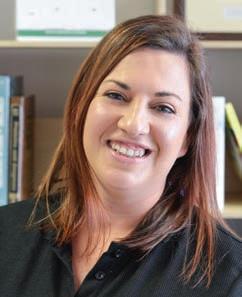

Using industry-leading computer vision for agriculture, Aerobotics provides a rich array of precision farming insights for growers to better measure, manage and protect their yields.
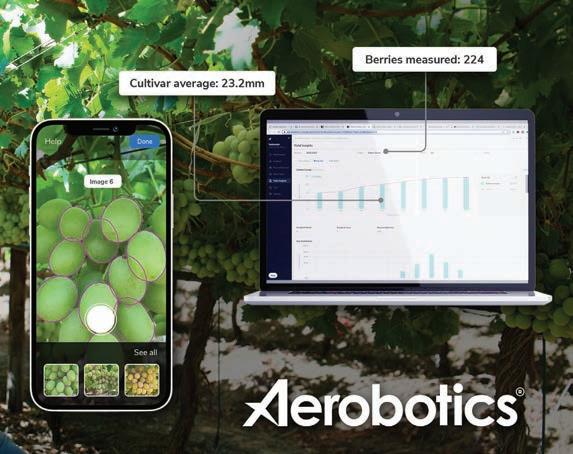
“Our rst product utilised high-resolution aerial imagery to provide individual plant performance metrics for orchards and vineyards,” says Paterson. “We then went on to create a second product that uses mobile phone imagery and machine learning algorithms to automatically identify and size the fruit in the eld. It also provides size distribution and growth curve data throughout the season for citrus, apples, stone fruit and grapes.”
“The current business environment is very challenging for start-ups,” says Paterson. “Rising interest rates and an in ationary market environment
have made investment capital harder to win and we are thankful for the support of our venture capital investors, through whom we have raised more than R496-million to date. We were fortunate that our Series B fundraise was oversubscribed thanks to our growing traction with an international client base. Our strategy is to continue focusing on our customers and providing them with valuable solutions to improve their business.”
PROBIGAL IS A MULTISTRAIN PROBIOTIC SPECIFICALLY DESIGNED FOR CHICKENS TO PROMOTE GUT HEALTH AND ALLEVIATE THE NEED FOR ANTIBIOTICS.Liesel van Emmenes
“AEROBOTICS WORKS WITH CUSTOMERS TO PROVIDE THE BEST YIELD INFORMATION TO AID AGRONOMIC DECISIONS – SUCH AS NUTRITION- AND IRRIGATION-RELATED AMENDMENTS TO MANIPULATE GROWTH.” – JAMES PATERSONAFRICA AGRIFOODTECH INVESTMENT REPORT
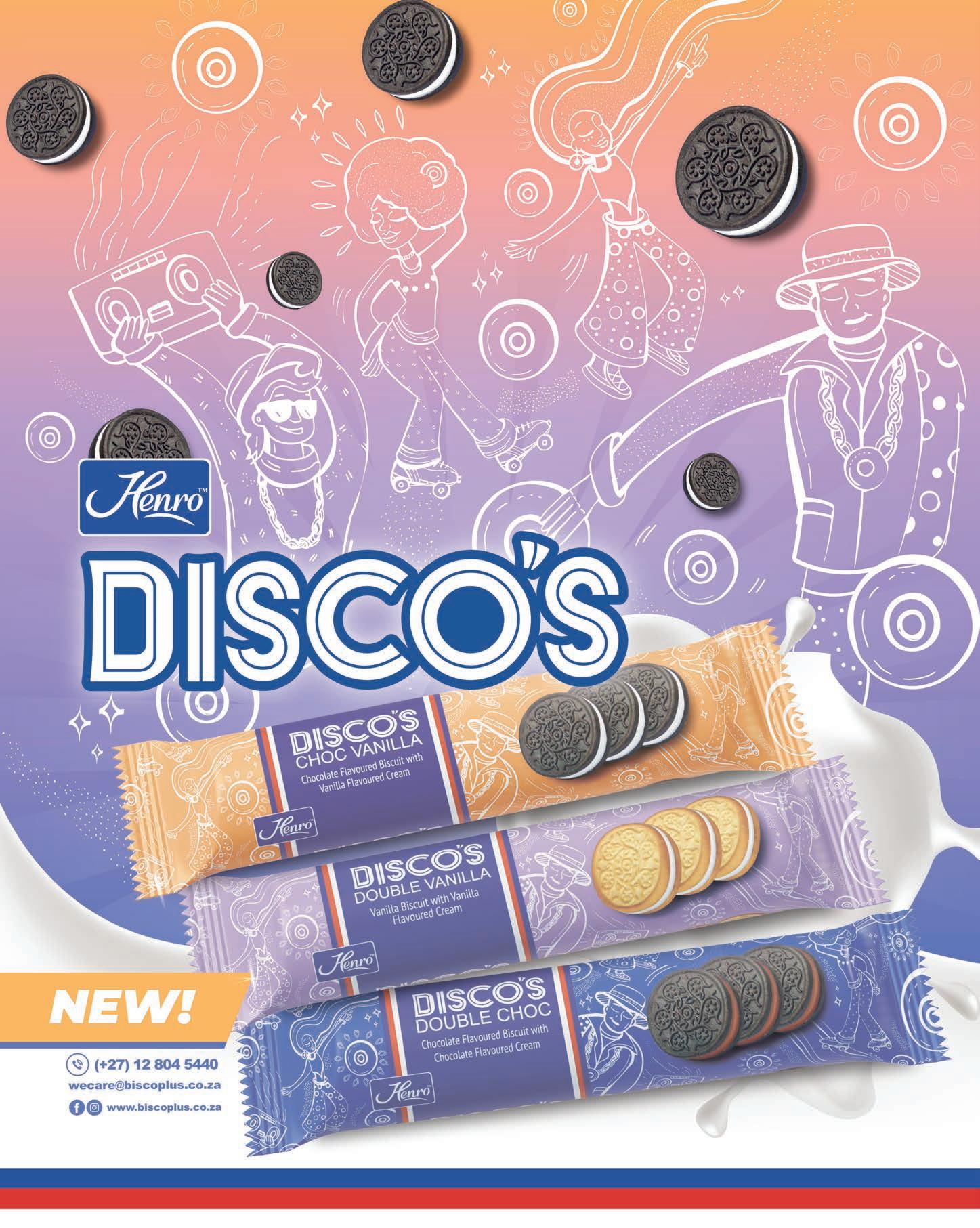
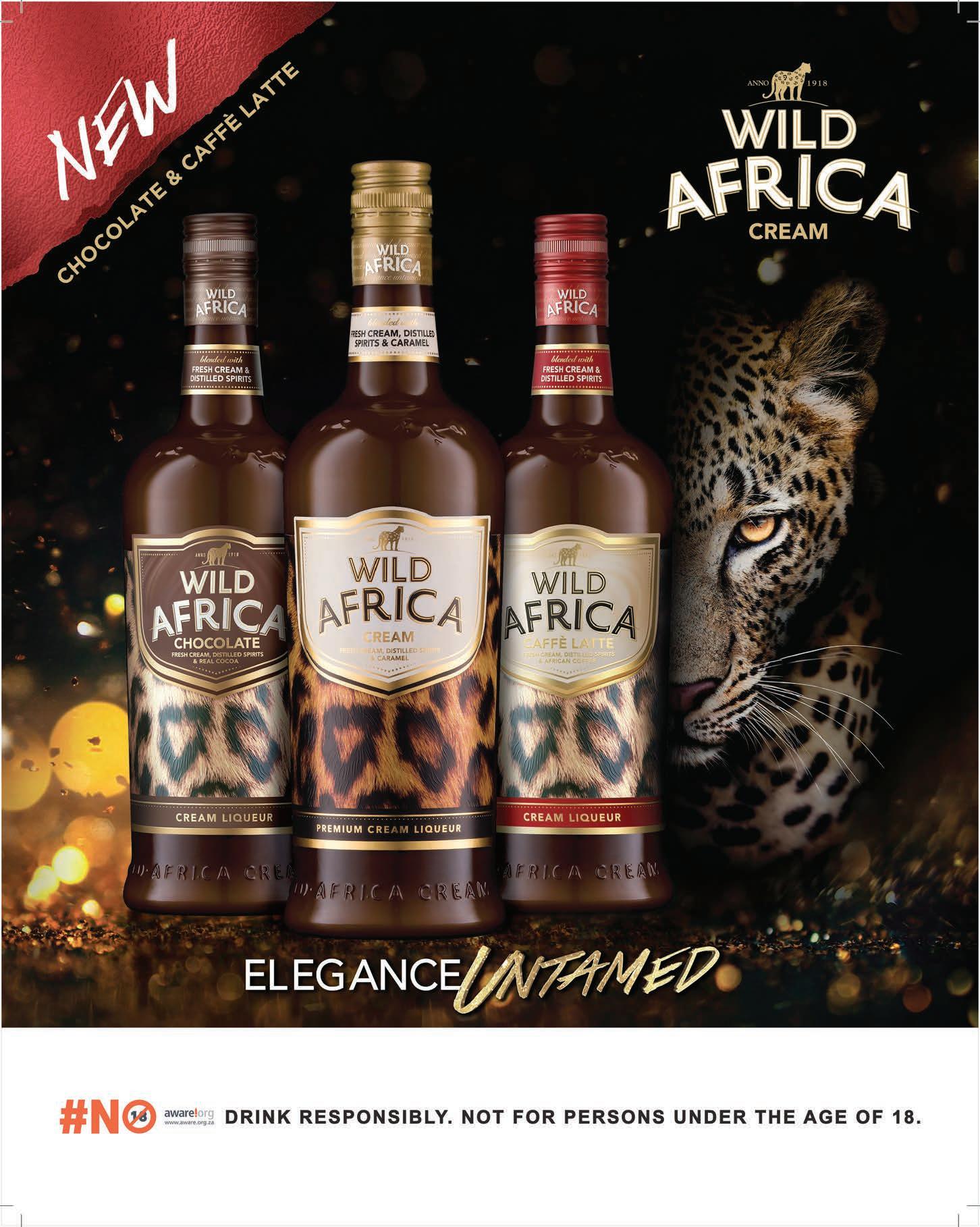
KEITH BAIN meets three women chefs who are reinvigorating South Africa’s restaurant landscape
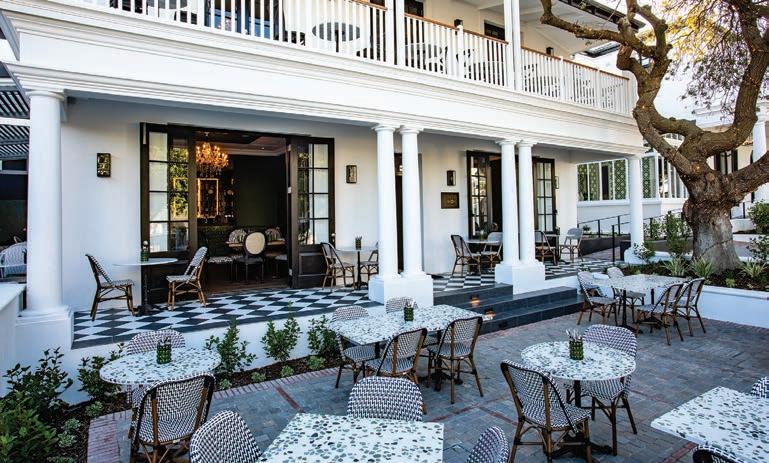
W“ars are started around tables, and wars are ended in the same way,” says Amori Burger, a chef with wide experience presiding over a variety of kitchens across South Africa. “It’s where people break bread, where families fight, and where couples make up. A lot happens over a meal.” Burger, who made her name as a bubbly TV chef with a knack for revamping restaurants, understands that food is both a social lubricant and a source of emotional connection. A meal can make or ruin your day.
Feeding people is a vocation, never simply a job, Burger says. Her mother was a caterer –and “a brilliant cook” – so she learnt from the best. The first “proper-no-messing-around” dish she learnt to prepare was a carpetbagger.
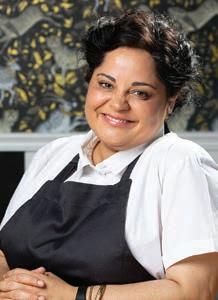
“It was the early 2000s, and that kind of thing – fillet with mussels in garlic sauce – was all the rage.” She laughs at the memory, amused by how tastes have changed.
For years, she’s been replacing overly complicated meals with nourishing dishes full of beautiful flavours, doing away with foams, gels and emulsions. Simplicity, she says, is a key ingredient for great cooking.
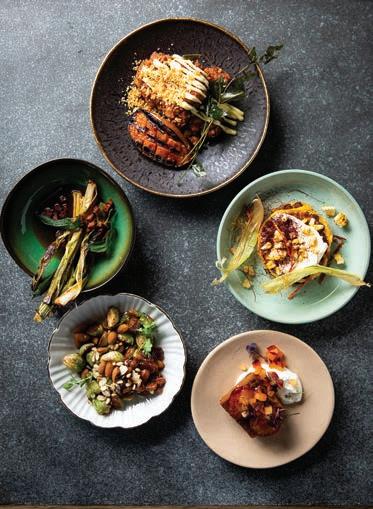
The concept for her latest restaurant, Upper Union, just off Kloof Street in Cape Town’s Tamboerskloof, is based on the idea of a family feast. There are sharing plates of simple, tasty vegetables and mains with hints of nostalgia: food prepared the way you might imagine your grandmother, if she were were a world-class chef with professional experience and a contemporary outlook, might prepare it.
“I want this to be like a family-style dinner party where you’re eating and I’m eating, and I’m saying, ‘Oh, did you taste the cabbage? Here, taste this! What do you think?’ Everyone’s laughing, and because it’s a family feast, someone ends up weeping over the rooi wyn.”
Burger’s first menu at Upper Union has a Cape Malay/spice route influence. She says she wanted to create dishes that paired with the historic ambience of the restaurant’s location.
There is also a dish inspired by her childhood. “It was my dad’s braai meal,” she says. “He would eat a lamb chop with spanspek and blue cheese – nothing else. That was his thing. So, I put a ribeye on the
menu with spanspek, watermelon and blue cheese and a pink peppercorn sauce. There’s nostalgia, but with a twist.”
Apart from recipes that need to evolve with the times, another thing Burger believes needs to change is how people are treated in restaurant kitchens. “Make no mistake: I’m strict, I studied cooking the French way, so I like things done properly. I am strong and can be fierce, but I refuse to treat people in my kitchen badly. The most valuable lesson in this business is to treat your staff with respect, let them create, help them to learn and nurture them.”
This naturally built-in nurturing instinct is exemplified by another go-getter chef whose devotion to her passion has put her restaurant on the global culinary map. Mmabatho Molefe, still in her 20s, opened her restaurant, Emazulweni (“in the heavens” in isiZulu), at the end of 2020 – in the middle of the pandemic. Located at Makers Landing at Cape Town’s V&A Waterfront, it has, in the last two years, seen Molefe showered with accolades. Last year she won Eat Out’s Rising Star award and has been named among The World’s 50 Best List of young people shaping the future of gastronomy.
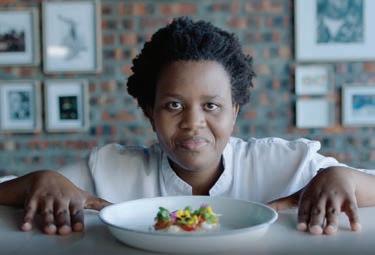
BURGER’S FIRST MENU AT UPPER UNION HAS A CAPE MALAY/SPICE ROUTE INFLUENCE. SHE SAYS SHE WANTED TO CREATE DISHES THAT PAIRED WITH THE HISTORIC AMBIENCE OF THE RESTAURANT’S LOCATION.Amori Burger Mmabatho Molefe Southern fried chicken with sides – Brussel sprouts, plum and buckwheat cake, cachapa and leeks. Upper Union Restaurant
What distinguishes Molefe, apart from being one of a small handful of black female chefs helming her own restaurant, is her commitment to telling the story of her heritage through her food. Her multicourse set menus are all about reinterpretations of traditional, indigenous dishes – her childhood memories transformed into contemporary dishes that can compete on the world stage. It has meant taking chances, pushing against the rather conservative tastes of westernised South African palates. She works with lesser-known cuts of meat, especially offal.
Molefe says that, like women, offal is underappreciated. She says it’s significant that offal plays a major part in keeping many South African households fed – often by women. It’s not simply about changing perceptions of what African food can be, but about putting her soul on the plate.
She also makes no apologies for dishes such as slow-cooked ulimi noshatini (ox tongue),


served with uphuthu namasi (Zulu pap with sour milk). And you might find beef heart biltong tartlet or a chicken liver and chocolate sandwich, and a beautifully creamy isiklabhu (samp with lamb and kidney), served with butternut puree, imfino (spinach and barley) and chakalaka.
Emazulwini’s atmosphere is upmarket but relaxed. You can watch Molefe and her chefs – an all-black-female ensemble – at work in the kitchen. Molefe is a kind leader: nurturing, loving and dedicated to creating an atmosphere where everyone in the team feels as though they’re part of the greater vision. That is the point: to present a truly South African culinary heritage in a context that is sophisticated and refi ned.
For Molefe, it’s been about staying true to herself and believing in her vision, which is not always easy in a fickle industry. However, she has managed to stick to her guns, eschewing trends in favour of tradition.
Her menu, which gets seasonal updates and revisions, exists in much the same spirit as Burger’s menu at Upper Union. It’s the concept of a family meal, gathering loved ones for a feast. And that, above all, knowing that being fed is an act of love.
All those top 10 lists are “men, men, men”, says Serushia Naidoo, who took up the head chef position at Truth Brasserie in Cape Town this year. “And those men can get kind of arrogant.”
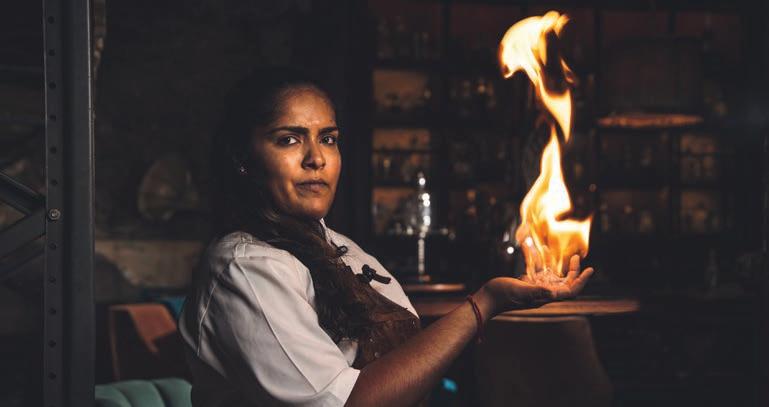
The institutionalised idea that men should dominate professional kitchens was built around the widespread idolisation of such legendarily great “bad boy chefs” as Marco Pierre White, driven home by the rise of that ego-forward persona à la Gordon Ramsey, whose television character borders on ludicrous, yet has cultivated enormous followings thanks to shows where swearing and treating kitchen staff with contempt is brokered as entertainment.
Naidoo says it’s acknowledged that women get treated as secondary citizens in the restaurant industry, not that this is unique to hospitality. “They get less pay, and they are less valued and appreciated.
“I think men assume that we women are only nurturing, only uplifting,” Naidoo adds. “They forget that women are also strong.” Starting as a young chef, she found herself in all-male kitchens where the atmosphere was borderline juvenile, full of sexist pranks and behaviour that would never fl y under her watch. She prefers to focus on the business of making great food.
Now she heads up one of Cape Town’s busiest daytime kitchens and has fashioned a novel food menu for Art of Duplicity, a secret-location speakeasy ranked among the world’s best 100 bars. “Being a woman of colour in this position in this industry is significant because we’re generally looked upon as ‘less’. I am a proud Indian South African woman, and we need more people like me in these positions.”
Naidoo says her job as head chef is about growing people and helping them achieve their dreams – dreams they maybe didn’t even realise they had. “What’s the point of being in an industry that demands so much from you but has some sort of glass ceiling for women?”
She says she can, when required, be a demon in the kitchen; the difference is that she prefers not to wield the whip the way many male chefs tend to do. “I favour women being supported in the kitchen. I like to lead with love, kindness and happiness first. I want people to be happy. If your work environment is unhappy, you’re going to be unhappy, and I think people will taste that unhappiness.”
Naidoo says that the South African Chefs Association has a dedicated Women in Culinary division that aims to fix the gender disparity in professional kitchens. Anyone looking to grow their careers in South Africa can look to the organisation for advice and support, though.
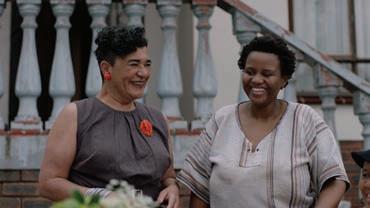
EMAZULWINI’S ATMOSPHERE IS UPMARKET BUT RELAXED. YOU CAN WATCH MOLEFE AND HER CHEFS – AN ALL-BLACK-FEMALE ENSEMBLE – AT WORK IN THE KITCHEN.ABOUT THE SOUTH AFRICAN CHEFS ASSOCIATION Karen Dudley and Mmabatho Molefe Serushia Naidoo
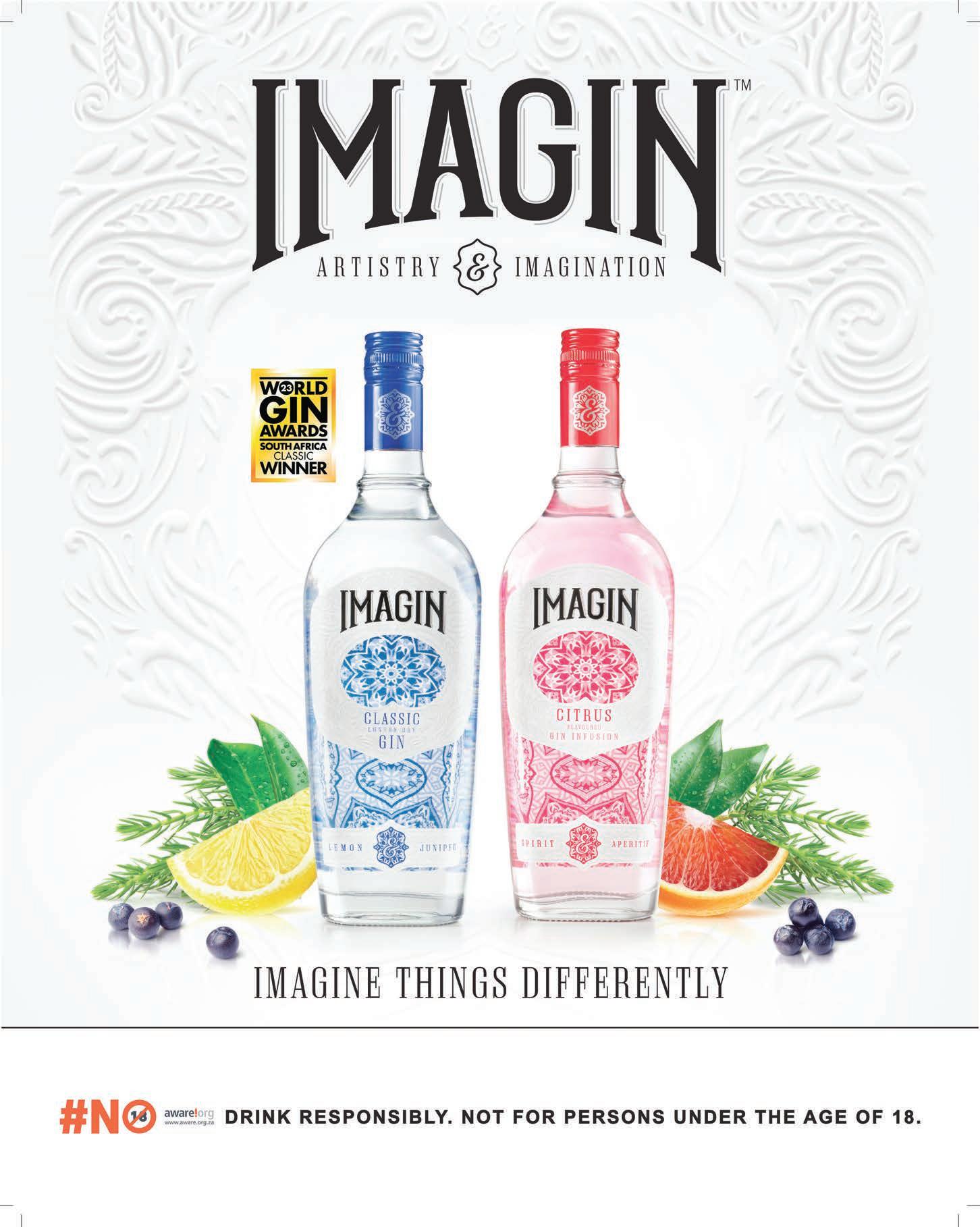
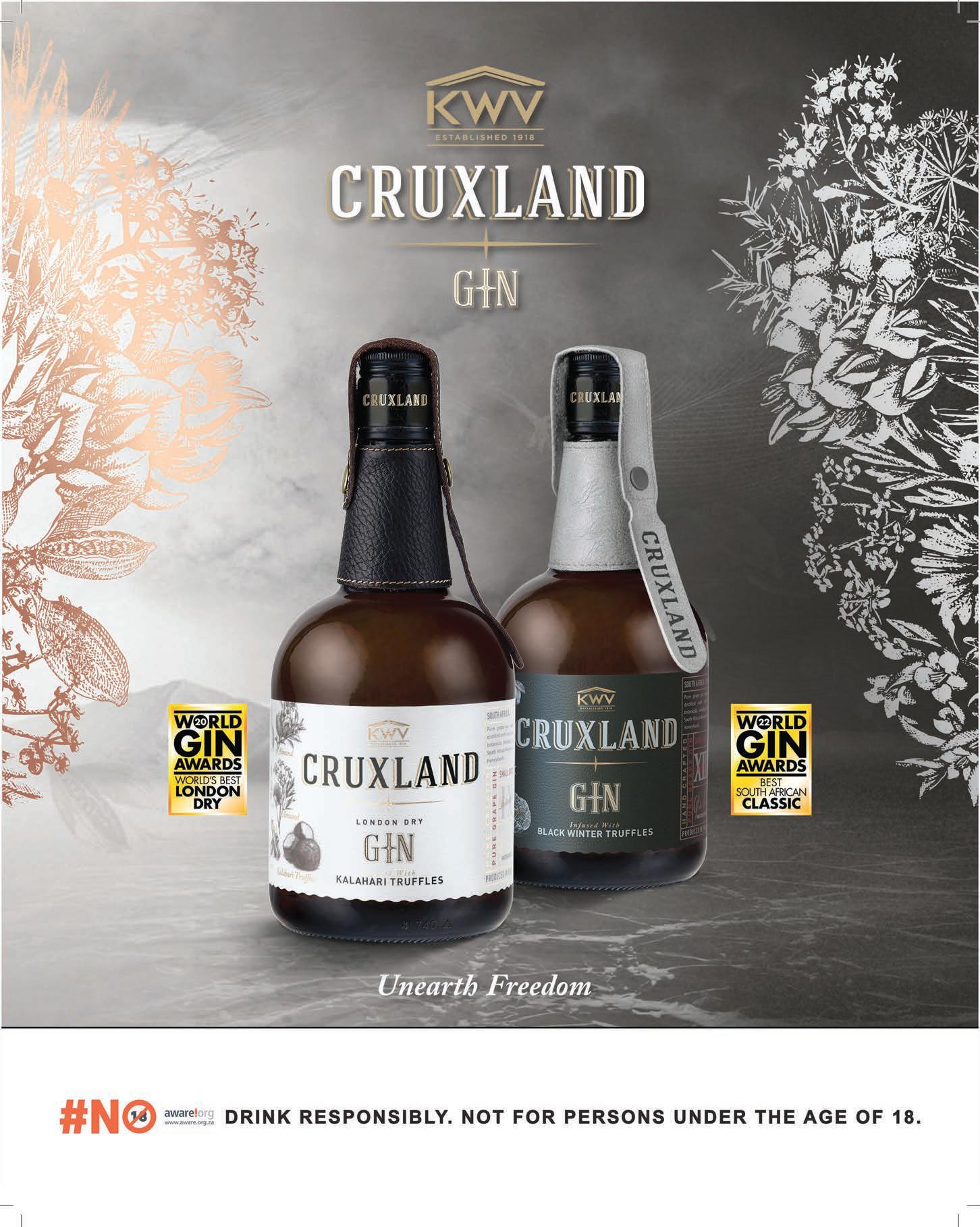
Abstaining needn’t mean sitting at home knitting while your boozy friends are hitting the town. A new era in social drinking is upon us, writes KEITH
BAINTo say nonalcoholic drinks are having a moment is putting it mildly. There’s a sizeable shift underway towards more responsible drinking. A tide of teetotallers is on the rise, plus people experimenting with part-time sobriety and others getting into health-inspired abstinence, so-called mindful drinking, or – on a night out – switching between alcoholic and nonalcoholic drinks, a practice known as “tiger-striping”.
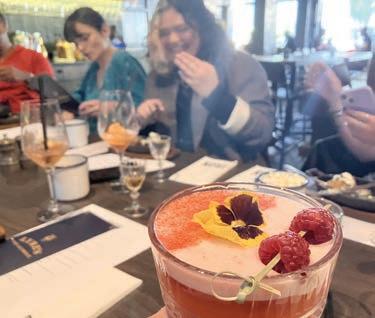
Last October, alternative culture platform Vice reported that while “ketamine, weed and mushrooms are doing just fine”, alcohol is in the midst of a public relations crisis, with 26 per cent of 16 to 24 year olds in Britain now describing themselves as “fully sober”. Vice further reported that an August 2022 study “found that almost a third of all pub visits are now booze-free”.
Last year’s IWSR analysis of the drinks market showed that sales of no- and low-alcohol beverages surpassed R200-billion, with more than 7 per cent growth across 10 key global markets, including South Africa.
Someone who understands the desire for strong flavour in an alcohol-free drink is Nic Jooste, who says he tried to capture the taste of the African bush – Kruger specifically – when he developed his Selati range of nonalcoholic spirits, named after the Ga-Selati River that runs through the reserve.

Jooste says he entered the market at the right time, just as alcohol-free drinks were emerging as the world’s fastest-growing beverage segment. Selati’s “African Summer” spirit is made with watermelon, pomegranate and hibiscus. “African Sunset” features marula and rooibos, and “African Savannah” is laced with “Kruger botanicals” and African maize. The label is strikingly African, its geometric design inspired by traditional Ndebele patterns.
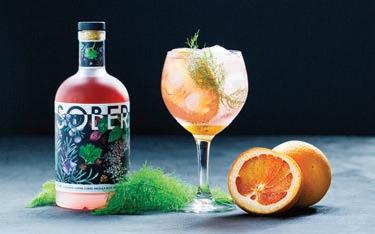
Selati wasn’t the first zero-alcohol spirit out of South Africa, however. Made with redistilled juniper in small hand-bottled batches, Saint was Mzansi’s first nonalcoholic gin, inspired by the microclimate of the Olifants River, according to its creators. The spirit is free of artificial ingredients and has a bracing flavour kick, making it perfect for a booze-free G&T.
What about the shock to the senses? The mouthfeel? That tang on the tongue that comes from the taste of alcohol? Where’s the gnah that for millennia has been enjoyed by the adult palate? What’s a grown-up to do on a night out?
Soda water with a dash of lime is fine, but what about that craving for something strong? If anything will put you off sobriety, it’s being faced by a syrupy-sweet virgin cocktail.
None of this might have been possible were it not for Johannes Le Roux who, years ago, discovered the burgeoning alcohol-free trend during a trip to the Netherlands. He returned to Cape Town, where he worked with his botanist aunt and a team of food technologists to develop the alcohol-free botanical tonic that became The Duchess, a gin-and-tonic-type premix drink that heralded South Africa’s foray into booze-free spirits. It sold a million units when it launched in 2015 and, by 2020, had gone international.
There’s a host of others, too. Made from natural botanicals – extracts of juniper, coriander, cardamom, and angelica all grown on an organically certified farm in the Overberg –Vermont VerGin comes in two expressions: Bloom (with extracts of allspice and rose pelargonium) and Limón (with lemon peel, lemongrass and cassia). In 2022, it was named Best Global Non-Alcoholic Beverage Brand at the Corporate Live Wire Innovation and Excellence Awards in London.
Abstinence is a range of alcohol-free drinks with much of the punch of a spirit, but none of the aftermath. Variants include Abstinence Cape Citrus, which is blended with local botanicals such as buchu, as well as pepper and fennel. Abstinence Epilogue X is produced using smoked, peated and blended malts, oak, honeybush, vanilla, cassia, cardamom, clove and impepho. There’s also a pair of Abstinence apéritifs made with buchu, aloe, African wormwood, cinchona bark, quinine and spices.
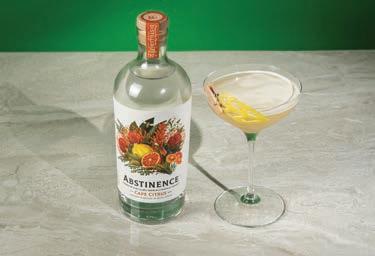
Bitterlekker is a nonalcoholic aperitif produced with seasonal ingredients at Babylonstoren in the Cape Winelands. No need to add anything – all the punchy flavours are right there in the tiny bottle.
Mahala (meaning “free”) is a triple-distilled spirit incorporating nine natural botanicals: clove, honeybush, angelica root, buchu, cassia bark, peppercorn, orange, cardamom and pelargonium citronella.
In 2021, Cape Town’s Simone Musgrave added alcohol-free Inspirit to her range of Musgrave Gins, “an aromatic, alcohol-free infusion made with 12 rare botanicals inspired by the ancient spice route of Africa”.
On a farm between Montagu and Barrydale, three “nonalcoholic distilled botanicals” were launched in 2022 under the Tahlia label. They’re named Pupa, Morphous and Papillon – each captures a different dimension of flavour produced by the prickly pear.
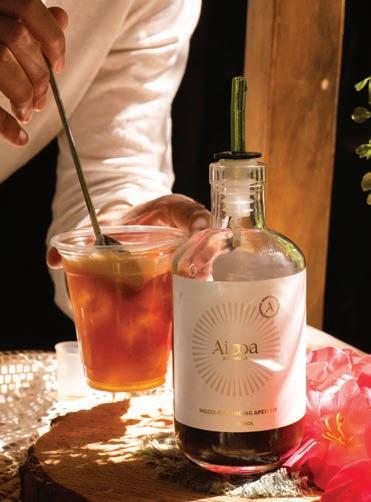
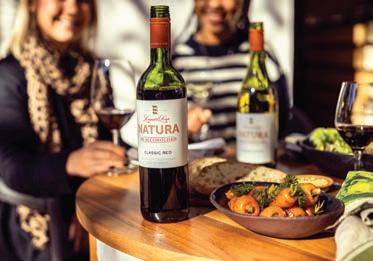
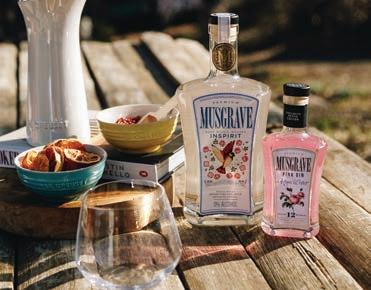
Aizoa Original is natural and earthy with a prominent taste of guayusa (a pleasant, slightly earth-tasting ingredient from the yerba mate family). The idea is that it’s neutral enough to be mixed into alcohol-free cocktails. There are also flavour-infused Aizoa varieties – lime and ginger, blueberry and vanilla, elderflower and buchu.
The biggest share of the nonalcoholic market segment is beer. Anheuser-Busch Inbev SA, the world’s largest brewer, plans to make 20 per cent of its beer low- or zero-alcohol by 2025.
Locally, Castle Free, Heineken 0.0 and Savannah Non-Alcoholic all launched pre-pandemic, and the global market is seeing a host of craft breweries entering the fray. Cape Town brewery Devil’s Peak has an excellent Hero nonalcoholic pale ale, which is barely distinguishable from a full-flavoured beer.
Also booming is nonalcoholic wine, although it’s the segment with the greatest difficulties in recreating desired flavour profiles
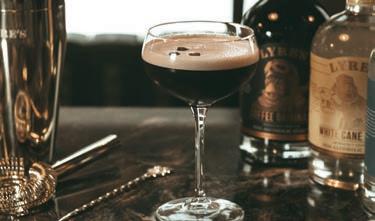
Alcohol-free bars have been trending in cities such as New York, Denver, Chicago, Los Angeles and Sydney for almost a decade.
On the menus are kombuchas, potent-tasting “functional elixirs” with ingredients that create a mild buzz, nonalcoholic India pale ales, and liquor-free cocktails you’d probably regard as “grown-up and complex”.
Such drinks are thanks to a burgeoning variety of zero-alcohol spirits that have followed in the wake of Seedlip, the world’s first distilled nonalcoholic spirit, launched in November 2015. To produce this upmarket, all-natural drink, Ben Branson tinkered in a kitchen in the English countryside, using a small copper pot still and a 1651 tome entitled The Art of Distillation that documents distilled nonalcoholic herbal apothecary remedies. It’s decidedly sophisticated, forming the base for an upmarket range of virgin cocktails served by trend-setting bartenders.
If Seedlip is the watchword for artisanal quality, then Lyre’s is the brand making a name for itself as a global leader in this rapidly evolving market. Lyre’s has quickly dominated the global market with its nonalcoholic spirit substitutes and landed in South Africa last year. It makes everything from dry gin-like spirits to something resembling tequila, plus coffee liqueurs and aperitifs.
With such booze-free spirits alongside numerous homegrown brands, there’s now

– de-alcoholising wine poses considerable challenges many winemakers believe are incompatible with wine-drinking culture.
To remove the alcohol from the Leopard’s Leap Natura range of de-alcoholised wines, the wine is spun through a system of cones at low heat. What comes out at the bottom is no more than 0.5 per cent alcohol by volume. Both its Classic White (a Chenin Blanc and Muscat blend) and Classic Red (Cabernet Sauvignon and Cinsaut) contain about one-tenth the calories of their full-alcohol counterparts.
Based in Bonnievale, Van Loveren Family Vineyards’ CEO Phillip Retief says the estate’s Almost Zero range of almost wines “taps into the growing trend of fitness-focused healthy living that is driving innovation of low-alcohol and alcohol-free products”. Its de-alcoholised range includes Wonderful White, Ravishing Rosé and Radiant Red – each is within the less-than-0.5 per cent alcohol range and has 75 per cent fewer kilojoules than a normal wine.
barely a bar in the country where grown-up nonalcoholic cocktails aren’t available. Get into the spirit of things at Art of Duplicity, Cape Town’s secret speakeasy, where mixologists create drinks according to flavour profiles rather than falling back on tried-and-tested options. Or try Joburg’s world-class Sin+Tax, a heavyweight bar with an apothecary-like atmosphere. The same applies at most high-end restaurants (such as Salsify at the top of Camps Bay, La Colombe in Constantia, and Zioux in Sandton) where bartenders believe their cocktails need to be taken as seriously as their thousand-rand-per-head food menus.
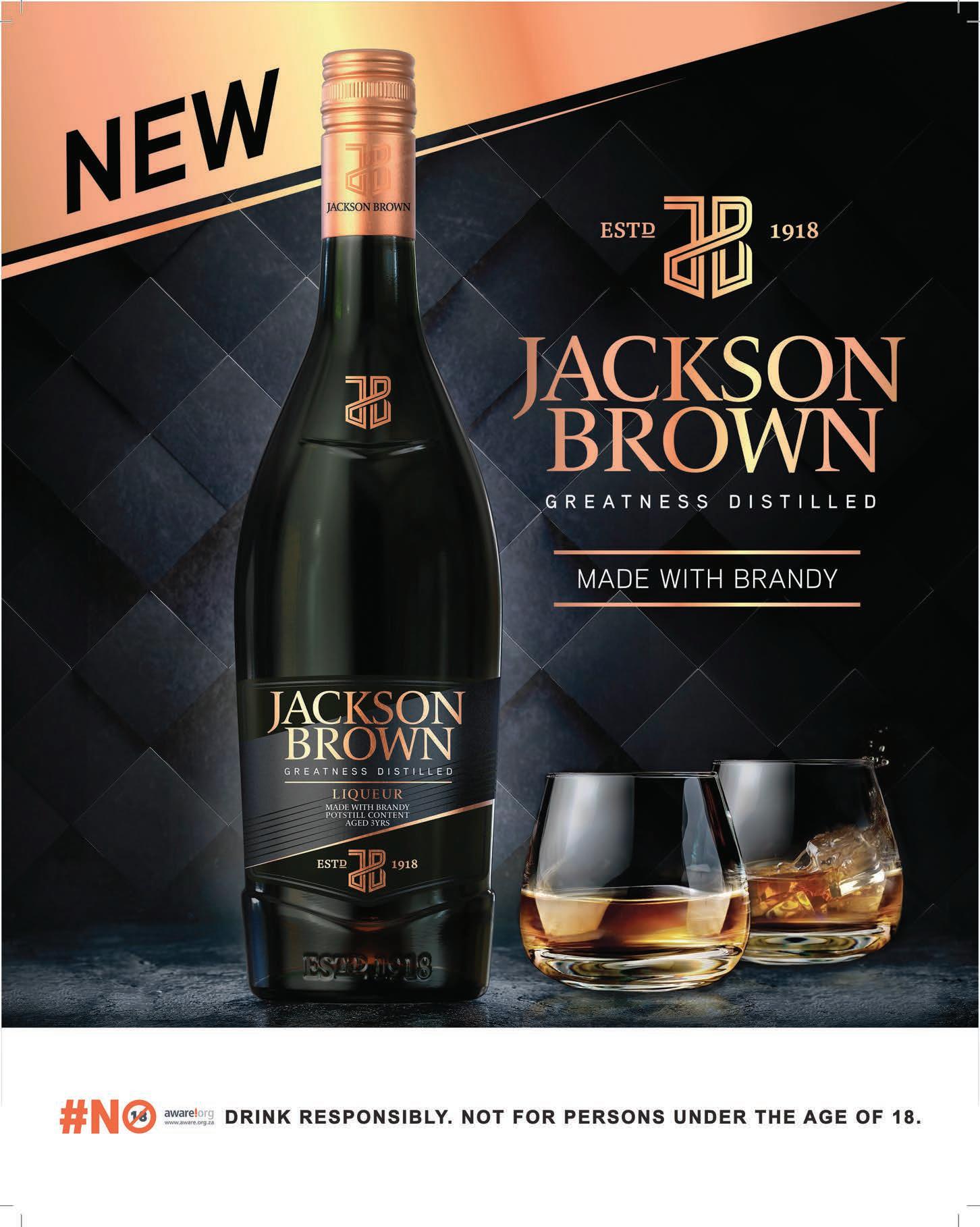
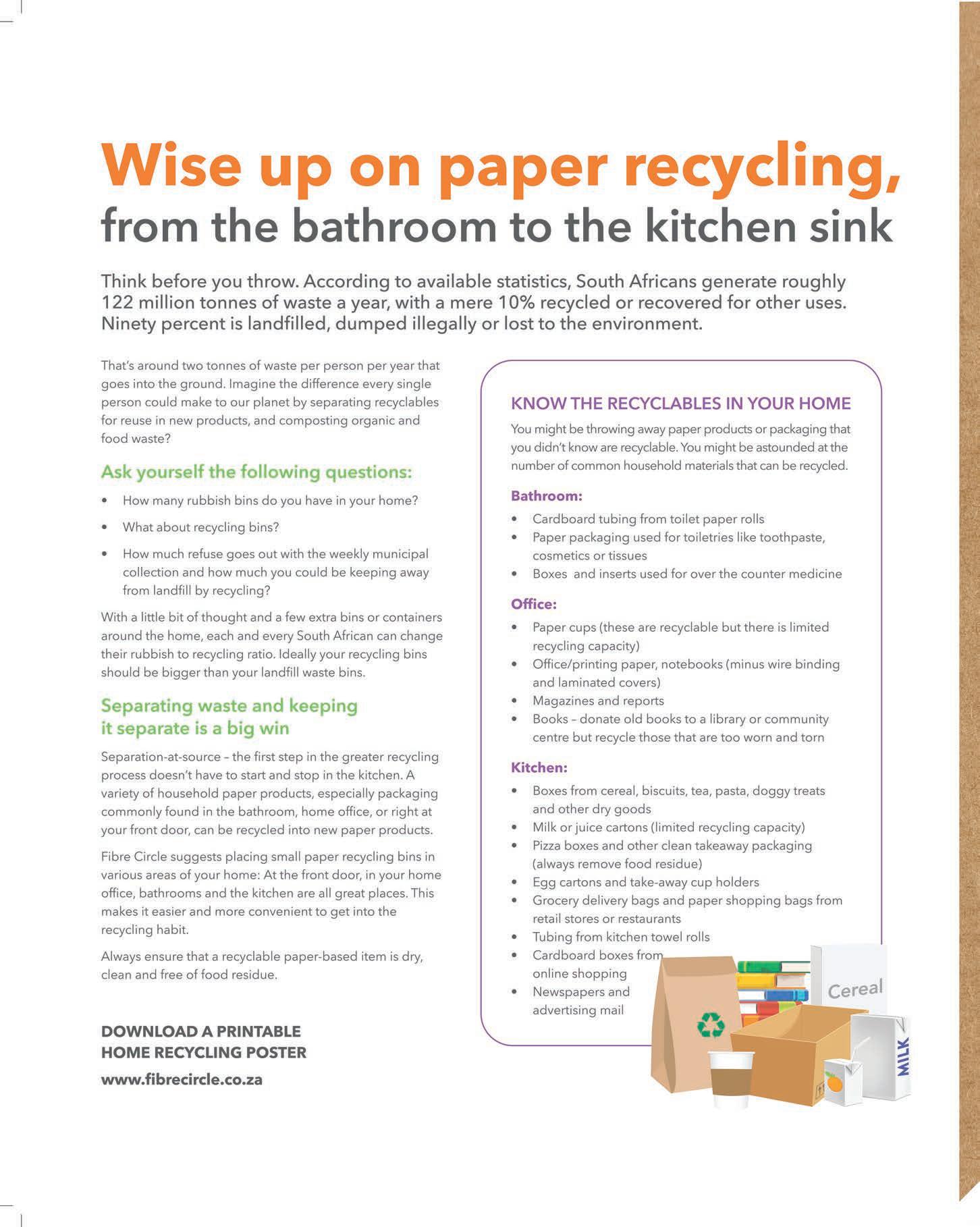
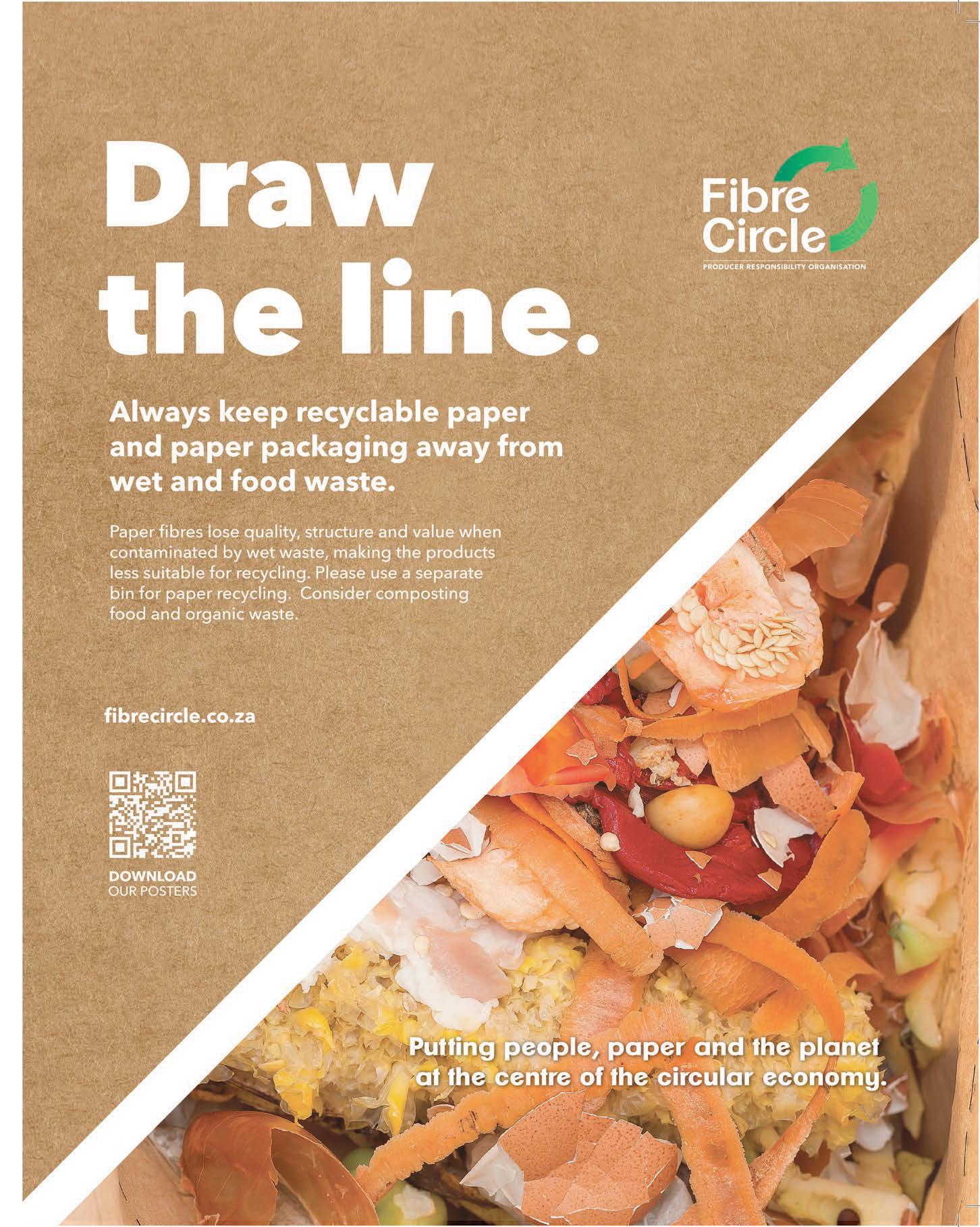
Sappi products are all manufactured from a renewable source, and the company is committed to protecting the environment and uplifting communities
Like many consumers worldwide, South African consumers want to know where products and materials come from, how environmentally friendly they are and whether the people involved in making them are treated fairly.
So, it’s good to know that all the products manufactured at Sappi Southern Africa are manufactured from a renewable resource –woodfibre – grown in plantations where the trees absorb and store significant amounts of carbon and where harvesting is continually balanced with replanting so that carbon stocks remain stable. This underpins our commitment to the United Nations Sustainable Development Goals (UN SDGs).
Not only does this approach support SDG13, “Climate Action”, but our responsible forestry practices are also in line with SDG15, “Life on Land”. Approximately one-third of the land we own and lease is managed for biodiversity conservation and incorporates seven proclaimed nature reserves (6 320 hectares) and about 156 other sites that are recognised and managed for the important conservation values they contain.
Our dissolving pulp brand, Verve, aligns with these goals and is produced at Ngodwana and Saiccor Mills in Mpumalanga and KwaZulu-Natal respectively. This product creates renewable alternatives for raw material feedstock to pharmaceuticals, foodstuffs and, primarily, textiles. It meets the needs of consumers looking for soft, breathable fabrics that hold colour well and drape beautifully, and who
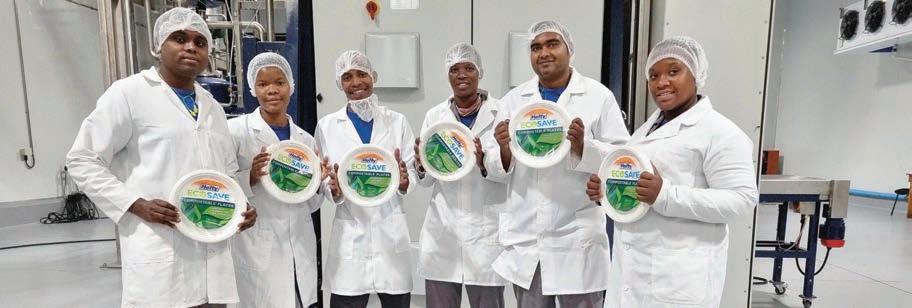
are concerned about climate change and deforestation. Verve’s partnership with one of our key customers on “Green Track” blockchain technology provides a forest-to-garment traceability solution for brand owners. This is a significant advantage, given the estimate that only five per cent of textile brand owners can trace their raw materials to their origin.
We also work to action SDG12, “Responsible Consumption and Production”, both in our own operations and for our consumers. One example is our PrimePak unbleached grade, used for takeaway foods. Once people have enjoyed their snack or meal, they can be secure in the knowledge that the packaging it came in doesn’t need to go to landfill as it is both recyclable and biodegradable.
Many South Africans are familiar with the red and white wrapper of our well-known, well-loved Typek office paper. What you might not know is that it is manufactured at Stanger Mill, which uses bagasse (sugar cane waste residue) to produce office and tissue paper. Or that the mill is taking that one step further to use bagasse in the manufacture of compostable thermo-moulded food-grade utensils such as plates and bowls.
In line with SDG8, “Decent Work and Economic Growth”, we focus on developing small and medium enterprises (SMEs), spending R245-million with SMEs in FY2022. We also invested R54-million in community development initiatives focused on promoting regional development, empowering communities and protecting resources.
Our impact on the South African economy is positive and significant. We have approximately 4 600 permanent employees and provide work for 9 300 people, who are employed by contractors working for Sappi Forests. This is important, given that employment opportunities in rural areas of South Africa are often extremely limited, and in view of government’s focus on rural development.
We’re proud of the contribution we make to South Africa, and we’re proud that we contribute one per cent of the country’s total foreign revenue by making local, global. This is not just through Verve, but also because the containerboard we produce supplies the fruit export industry with most of its packaging requirements. This industry contributes around four per cent of South Africa’s foreign revenue.
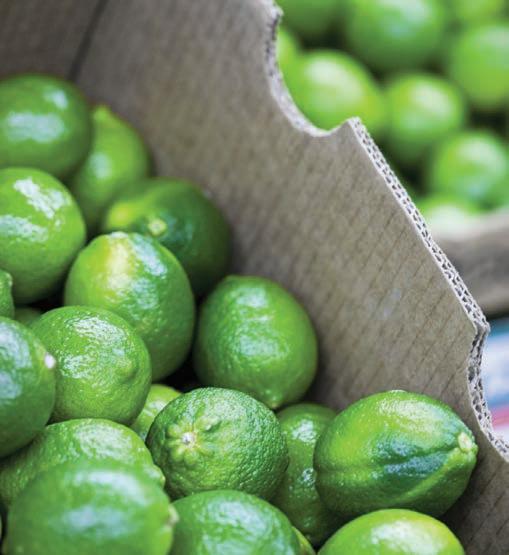
We’re proud that our “Made in South Africa” products and initiatives make a positive impact in our country and around the world.
Scan this QR code to go directly to the sappi website.

For more information: www.sappi.com


Warwick Junction’s early morning market in Durban is bustling with noise as traders display their wares to commuters traversing the city and its surroundings.
Recently, the sound of children laughing, crying, playing and rhyming in unison has been added to the bustling noise. Follow the sound and you come to a rather unexpected pop-up micro childcare facility.
The result of the collaborative work of advocacy group Asiye eTafuleni (AeT), the facility is based in what was once an unused area of the traders’ market. Its ready-to-assemble structural elements are made from affordable and readily available plywood built and treated for weather resistance.
In keeping with existing city regulations for home-based facilities, the 9m2 play area caters for a maximum of six children, with additional space for two “childcare crates”.

AeT has an established reputation for finding innovative solutions to the daily challenges of
informal traders. The pop-up childcare facility is part of its journey to finding feasible and scalable solutions that benefit both mother and child. A significant challenge for the programme is spatial planning, where policymakers and local government officials prefer brick-and-mortar structures that are often far from a trader’s place of work.
“Continuous consultation with all stakeholders in the informal trading environment is necessary to influence a shift in thinking not only around relevant childcare in spatial planning, but also the amendment of bylaws that criminalise and stigmatise the sector as a whole,” says AeT’s Richard Dobson.
Bringing together its understanding of the informal trading sector and the quest for practical and innovative solutions, AeT created childcare crates similar to the boxes traders use to store and transport their inventories. However, the childcare crate folds out to become a functional space that provides hygienic nappy change, sick bay, food
preparation and breastfeeding areas. There is also additional storage space for mattresses and supplies. At the end of each day, the childcare crates are easily folded away for overnight storage, ready to resume childcare duties in the morning.
About 6 000 informal workers depend on Warwick Junction for their livelihood. More than half are women, the majority of them mothers. Inconsistent, low income means they cannot take time off work or afford safe, quality childcare. Crèches – many of which do not accept children under three years – are often far from the market, opening after the traders’ working day begins and closing before it ends.
“It’s difficult for informal working mothers to practise optimal childcare,” says Dobson. “As a result, many mothers couple their maternal duties with productive labour.”
Visit any market and you’ll find women caring for their babies and toddlers, making makeshift cribs from boxes or creating playpens under their trading tables. These conditions are hazardous, and mothers are often met with contempt by other traders and customers.
A dedicated and vocal advocate for the benefits of exclusive breastfeeding, AeT has built the pop-up micro childcare facility and care crate solution on the principle of mother and child proximity. “Proximity of mother and child is vital in the early years of life,” says Dobson. “It enhances the likelihood that a mother will breastfeed her child – a major contributing factor to the child’s health and development. It further enhances the mother’s ability to work in the informal economy, matching trading hours and providing the added advantage of being able to check up on the child.”
One trader shares her experience of the facility: “I have been trading in chickens for the past eight years. I am a mother of two: a four-year-old daughter and a two-year-old son. I am grateful for the childcare facility introduced by Asiye eTafuleni. Before, I was compelled to bring my kids to work or leave them with my neighbours. It was extremely difficult and impossible to work under these circumstances. My fellow traders used to complain that bringing our kids into the workspace was an inconvenience in conducting business. The facility has been of great assistance. I am now able to conduct my business freely, knowing my kids are properly looked after at the childcare facility.”
THE CHILDCARE CRATE FOLDS OUT TO BECOME A FUNCTIONAL SPACE THAT PROVIDES HYGIENIC NAPPY CHANGE, SICK BAY, FOOD PREPARATION AND BREASTFEEDING AREAS.The childcare crate.

South African handmade product manufacturers have a global opportunity, but only if they work together, writes
TREVOR CRIGHTON
The local footwear industry is primed for success with all the hallmarks of being a good contributing sector to the South African economy. That’s the view of Veldskoen co-founder Nick Dreyer. “We’ve always made great shoes; the only problem is we’ve never told anyone.” With global supply chains under increasing pressure, Dreyer says that South Africa is a viable footwear import source for quality, handmade footwear into the United States and the United Kingdom, but it will take collaboration between brands to make it a success.
“The story of the decimation of South Africa’s textile industry is well known, but what people don’t know is that many of those talented artisans have turned their hand to producing other related products, such as shoes,” says Dreyer. “While the industry compressed, the skills remain. Now we need to harness our collective power to reach global markets. The challenge is that it’s difficult to plan for opportunity. It doesn’t present itself as a strategic plan, it comes organically.”
Dreyer has attempted to formalise collaboration across South African handmade product producers, but says that the challenges of operating his own business means he hasn’t been able to devote the attention it requires. “There’s a world where a formalised entity could work,” he says. “I tried to do it, and I have what I believe will be a successful formula, but it needs a champion. Until then, I don’t think a formal body will happen.”
International opportunities exist in abundance. United States retailers are always on the hunt for the next trend and Dreyer believes that the creativity behind South African products makes them prime candidates for being picked up globally. “Global retailers
are looking out on social media platforms for the next ‘cool’ thing, and we have a major opportunity there. The more South African products are accepted and loved in other parts of the world, the keener people here and abroad will be interested in buying them.”
Veldskoen has collaborated with global brands, including DHL and Nandos, and locally born international fashion brand Tayla Jane. Founder, private safari guide and TV presenter Tayla McCurdy, who developed her safari-inspired fashion brand based on her experiences in the bush across Africa, went straight to Veldskoen when she wanted to add footwear to the range. “I had a pair of bush shoes on a job in Zambia that literally fell apart within two months,” says McCurdy. “A friend suggested I test out a pair of Veldskoen shoes, so I did the ‘Tayla Test’ and tried to walk them into the ground. I was amazed when they just kept going.
“As I learned more about the Veldskoen brand, the way it does business and its community development programmes
The Department of Trade, Industry and Competition’s Clothing Textile, Footwear & Leather Master Plan aims to build the local industry and make it a major player by 2030. It hopes to increase South Africa’s leather, leather goods and footwear output by 75 per cent between 2019 and 2025 to R25.62-billion, increase domestic output from R10.03-billion to R18.13 billion, and export output from R4.65-billion to R7.91-billion in the same period. The knock-on effect on employment opportunities in the sector is projected to be an increase of 56 per cent to 32 363.
Source: Department of Trade, Industry and Competition
resonated with me, so it was a no-brainer to go to it to work on a shoe for the line.”
The two companies collaborated on the development of a safari boot able to handle the harsh African bush and still be fashionable enough to wear around high-end lodges. “The collaboration has received lots of local and international traction with both men and women because of the style and utility of the shoe,” says McCurdy. “Both brands had international followings before and now we’re helping each other reach new audiences. Local companies should be helping each other reach their full potential. When brands align, we can do well and also do great work in building communities and economies.”


“THE MORE SOUTH AFRICAN PRODUCTS ARE ACCEPTED AND LOVED IN OTHER PARTS OF THE WORLD, THE KEENER PEOPLE HERE AND ABROAD WILL BE INTERESTED IN BUYING THEM.” – NICK DREYERVeldskoen Heritage J-Bay Blue Nick Dreyer The Veldskoen.
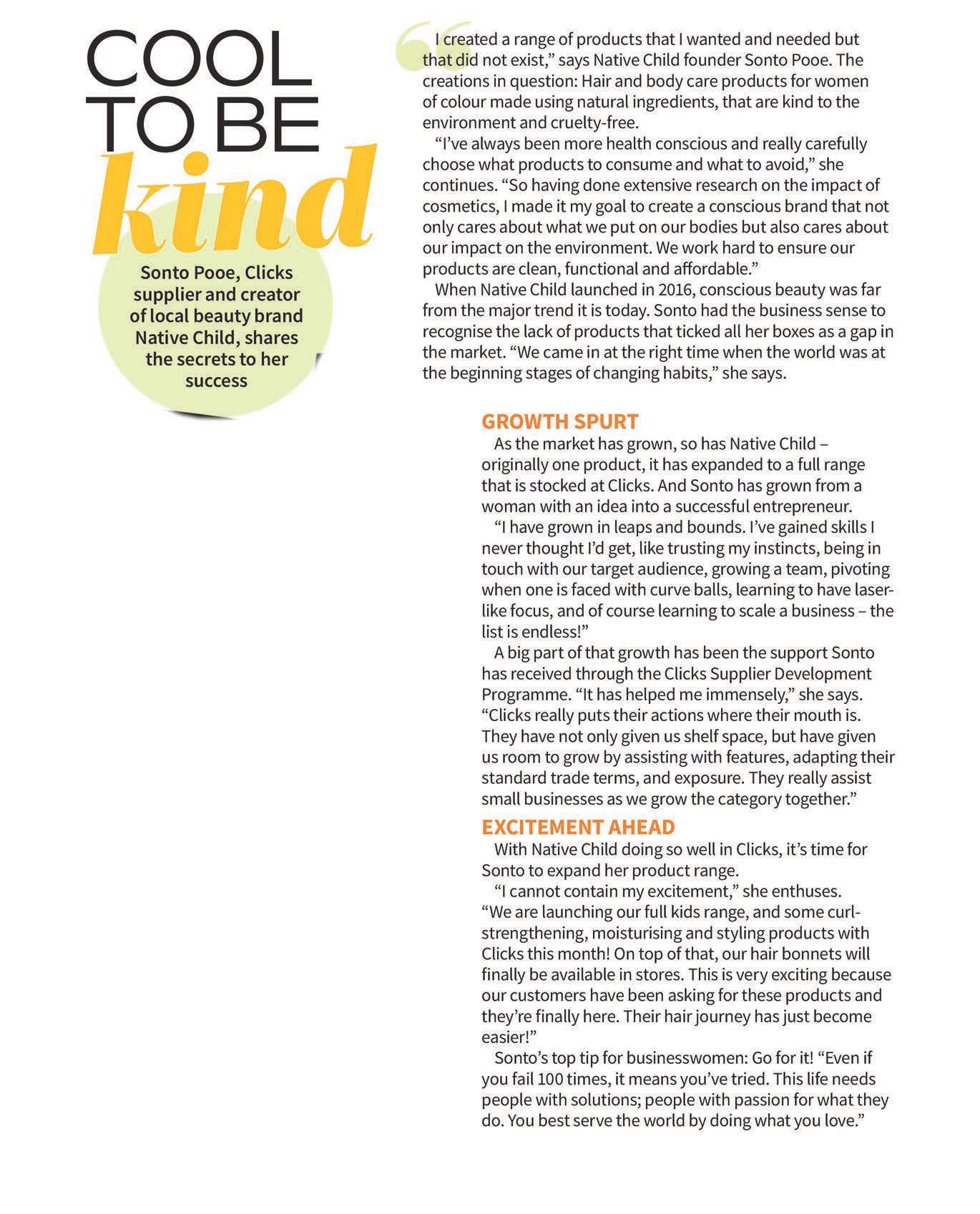







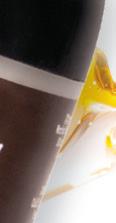




















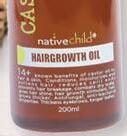

Clicks-branded products offer great quality at affordable prices. This includes a niche clothing range of baby fashion and a wide range of baby accessories and essentials.
The Made 4 Baby range is the fastest-growing brand in the value-for-money baby products category, while Made 4 Mom breast pads won the Best Breast Pads category at the BabyYumYum.co.za Product of the Year Awards in both 2021 and 2022.
In today’s tough retail environment, brands need to go above and beyond to meet customer needs and expectations. This is especially true for the baby market. Parents want products and services from brands whose quality and expertise they trust and align with their ethos.
When catering to this often harried group of customers, Clicks has stuck to its strategy of offering great value, convenience and differentiation.
With more than 850 stores nationwide, Clicks provides convenient access to a wide range of high-quality, affordable baby products, along with mom and baby wellness services. This offering has been further expanded with the roll out of the Baby Store-in-Store concept at top Clicks stores and four new stand-alone Clicks Baby stores at leading destination malls across South Africa.
According to Nielson, Clicks has held 21.3 per cent of the local baby market over the past 12 months, with growth driven by Clicks Baby Stores, Clicks-branded baby products and the Clicks online platform.
The brand introduced its first stand-alone Baby Store in 2021 at the Gateway Theatre of Shopping in Durban. Since then, it has opened similar stores in Johannesburg, Cape Town and Pretoria, with plans to open seven more by the end of 2024.
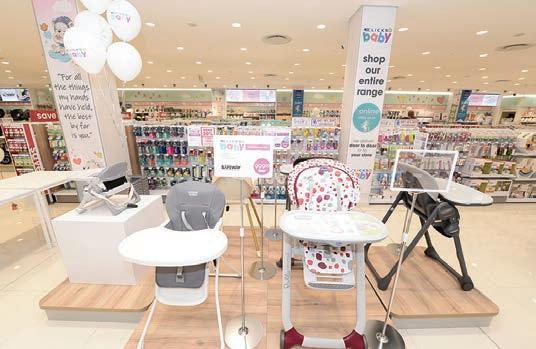
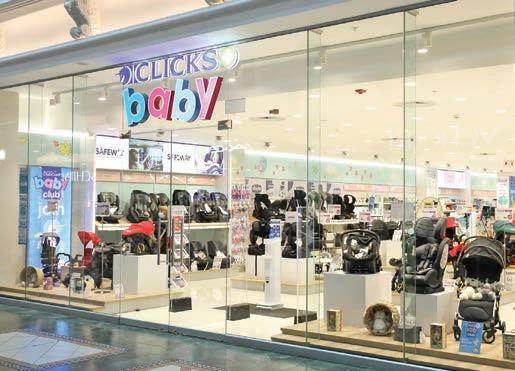
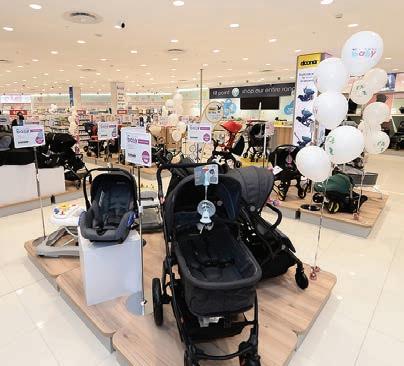
Clicks Baby Stores offer exceptional value for money and feature a wide range of mother and baby products, including baby hardware, accessories, health, foods, diapers and wipes and baby toiletries. The stores serve as a showroom for online purchases of larger baby accessories and goods, such as prams, car seats and furniture, not normally found in a traditional Clicks store.
There are special considerations when creating a dedicated baby goods shopping experience. The stores have been designed purposefully with convenience in mind, featuring wider aisles for prams and strollers, dedicated areas for breastfeeding and nappy changing, a kiddies corner to entertain toddlers, a gift registry and a wrapping service. The stores also offer webinars and baby educational sessions hosted in partnership with baby experts. Furthermore, the online shopping experience is available in-store, where well-trained service advisers with good knowledge of the range are equipped with tablets to navigate customers through the online assortment, with the option of home delivery or Click & Collect at any Clicks store in the country.
The Clicks My Earth range offers sustainable everyday essentials aligned with Clicks’ commitment to building a healthier planet, while Clicks Expert is a range of specialised, dermatologically approved skincare products for adults and children alike.
Clicks also offers even more choice with exclusive brands such as Oh So Heavenly, Sorbet, Body Shop, and Baby Hood wooden furniture.
More than 40 per cent of products sold through Clicks Baby Stores are produced locally, including Clicks-branded product suppliers that manufacture its diapers, baby foods, baby toiletries and mother care accessories. Local brands, such as Oratile Kids, Afrobotanics, Portia M, Zuru, and Purity, are also available at Clicks Baby Stores.
Clicks Baby Club members can stretch their rands further by earning double points on all purchases (excluding legislated goods) and instant savings with 10 per cent off on all purchases over R2 000 and access to exclusive Baby Club competitions, vouchers, and other special benefits.
With its customer-centric approach, extensive retail network and wide range of baby products, Clicks is well-positioned to be a parent’s first choice for stress-free, wallet-friendly baby shopping.
MORE THAN 40 PER CENT OF PRODUCTS SOLD THROUGH CLICKS BABY STORES ARE PRODUCED LOCALLY, INCLUDING CLICKS-BRANDED PRODUCT SUPPLIERS THAT MANUFACTURE ITS DIAPERS, BABY FOODS, BABY TOILETRIES AND MOTHER CARE ACCESSORIES.
